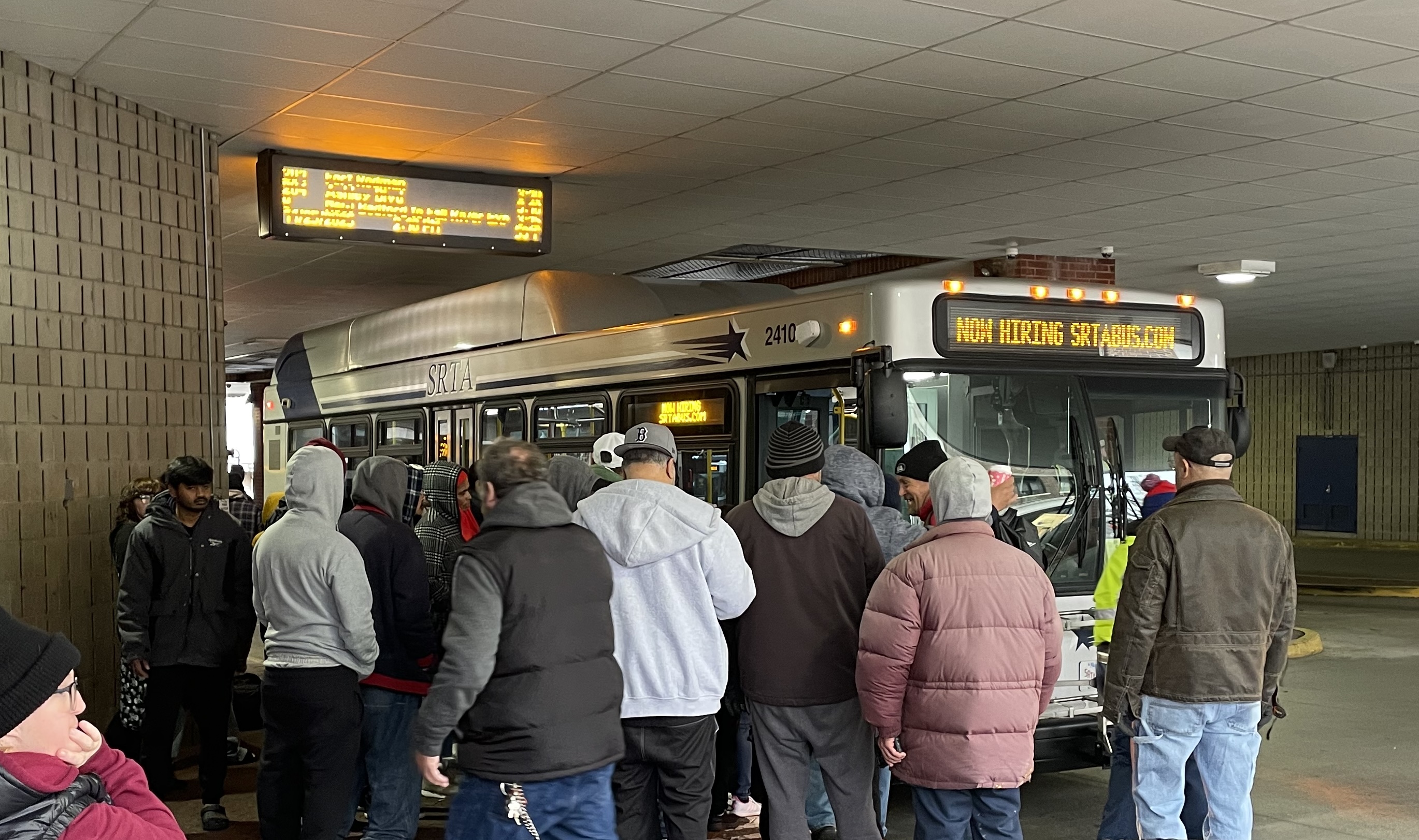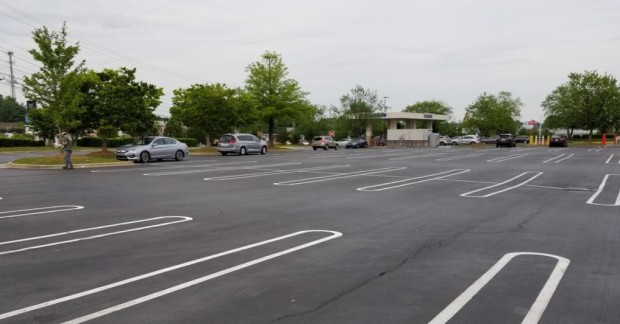Note: this is an archived version of our guide, reflecting the project as of May 26, 2022, when we updated the article with new details from a federal funding grant application from MassDOT and the City of Boston. Rather than re-writing this article and losing some of the details about the project's history, we've opted to maintain this article as an archival record. Read the most up-to-date version here.
Since 2013, the state's leading transportation agencies have been planning a massive reconfiguration of Interstate 90, Soldiers Field Road and the Framingham/Worcester railroad line along the Charles River waterfront in Allston.
If and when the project is finished – potentially sometime in the early 2030s – Allston will have new and upgraded bike and pedestrian connections to the Charles River, a new waterfront park, a new grid of local streets to set the stage for a huge new urban neighborhood, and a major new commuter rail station that's directly connected to Kendall Square via the Grand Junction rail line.
It's being called the "Allston Multimodal Project," and over the next two years, it's expected to go through a federal environmental review process that will determine many of the details of how the project gets built.
This is a story that StreetsblogMASS expects to cover in detail over the next few years, but on this page (which will be updated as new details become available), we're providing a high-level overview to help people understand the broad outlines of what's being proposed, and how advocates are hoping to improve the plans before it goes under construction for most of the 2020s.
Where is it happening?
The project area encompasses a 90-acre wedge of land that's shaped like a stingray swimming towards Belmont. It's about a mile south of Harvard Square, and about 3 miles to Government Center in downtown Boston:

What's being proposed
This design has evolved considerably since 2013 and is likely to evolve further in the next few years, but this map illustrates the project's major elements as of May 2022:

The project's proposed new bike and pedestrian accommodations, new streets and highways, and new transit facilities are outlined in slightly more detail below.
Why is MassDOT doing this?

In 2013, the private-sector freight railroad CSX vacated its railyards in the project area, which freed up 30 acres of land between the Turnpike and the commuter rail line.
Around the same time, MassDOT started raising the alarm that the viaduct carrying I-90 through this area was in bad shape, and needed to be replaced (see the presentation slide at right, from April 2014).
The transition to all-electronic tolling at the end of 2016 opened up additional opportunities. Until then, the state had been forced to maintain a maze of queuing lanes where traffic used to wait to go through the tolls; the new technology rendered many of those ramps unnecessary.
And underneath all of that unwanted transportation infrastructure lies 90 acres of extremely valuable real estate owned by Harvard University. They haven't shared any specific plans, but the university is already expanding its campus along nearby Western Avenue, and its officials have talked about their ambitions to make the area the "next Kendall Square."
Because they control the real estate, and also have considerable political and financial influence, Harvard's real estate interests play a major role. The university has specified that the project will need to maximize the "technical feasibility and economic viability" for development on their land (read more on Harvard's financial interests here in the "who's going to pay for it?" section below).
Finally, the project opens up numerous opportunities to make better connections for bikes, pedestrians and transit users within and across the project area. Harvard wants a new commuter rail station as part of the project (more on that below) and a walkable grid of new city streets through their land; Allston neighbors see an opportunity to gain better access across the Turnpike and to the riverfront.
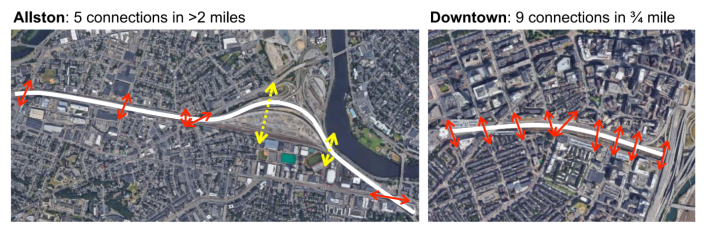
West Station and the Grand Junction
A new "West Station" would serve trains on the Framingham/Worcester commuter rail line plus a potential new rail line to Kendall Square and North Station via the Grand Junction right-of-way. The project would also build new dedicated rails for the Grand Junction line between West Station and the BU Bridge, and a bike, pedestrian, and transit-only roadway would connect the new station to Malvern Street, offering a short walk to the Packards Corner Green Line stop.
At the MBTA's request, the project also makes room for a four-track layover yard where up to eight commuter rail trains could be stored during off-peak hours.
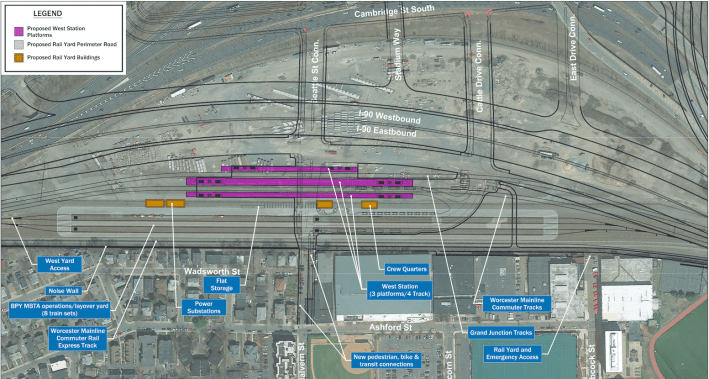
The timing of when West Station would be ready for passengers is an unresolved point of contention. MassDOT officials have, in the past, said that they might delay the transit station until Harvard builds out the surrounding neighborhood, possibly not until 2040. Project officials now say that the station would be built "as part of the project," and be complete by 2032.
Transit advocates and a number of elected officials would still like the state to improve commuter rail service on Framingham/Worcester line during the 10-year construction period when traffic flow on the Turnpike and Soldiers Field Road will be significantly constrained. TransitMatters has advocated for upgrading stations and electrifying the Framingham/Worcester line to allow for frequent, all-day regional rail service to move thousands of additional commuters who would otherwise drive on the Turnpike.
The Paul Dudley White Path and new bike/pedestrian connections
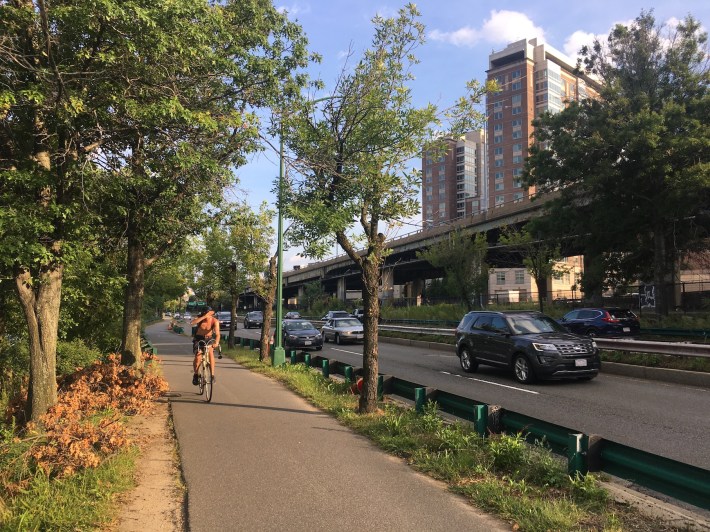
In many places through the project area, only a battered guardrail separates the Paul Dudley White waterfront bike and pedestrian path from the noise and pollution of Soldiers Field Road (both are maintained by the state's Department of Conservation and Recreation).
By relocating Soldiers Field Road away from the waterfront, the Allston Multimodal Project could create considerably more space on the waterfront for bike and foot traffic, plus new parkland.
The current plan also includes another new separated bike path that will connect the site from east to west, a rebuilt Cambridge Street with new crosswalks and protected bike lanes, a wider, ADA-accessible replacement for the Franklin Street pedestrian bridge over the Turnpike at the western edge of the site, and a car-free transitway from West Station to Malvern Street and Packard's Corner.
Advocates would also like to see a new bike-and-pedestrian connection to the river from Agganis Way on the Boston University campus.
Stuffing 200,000 cars down 'The Throat'
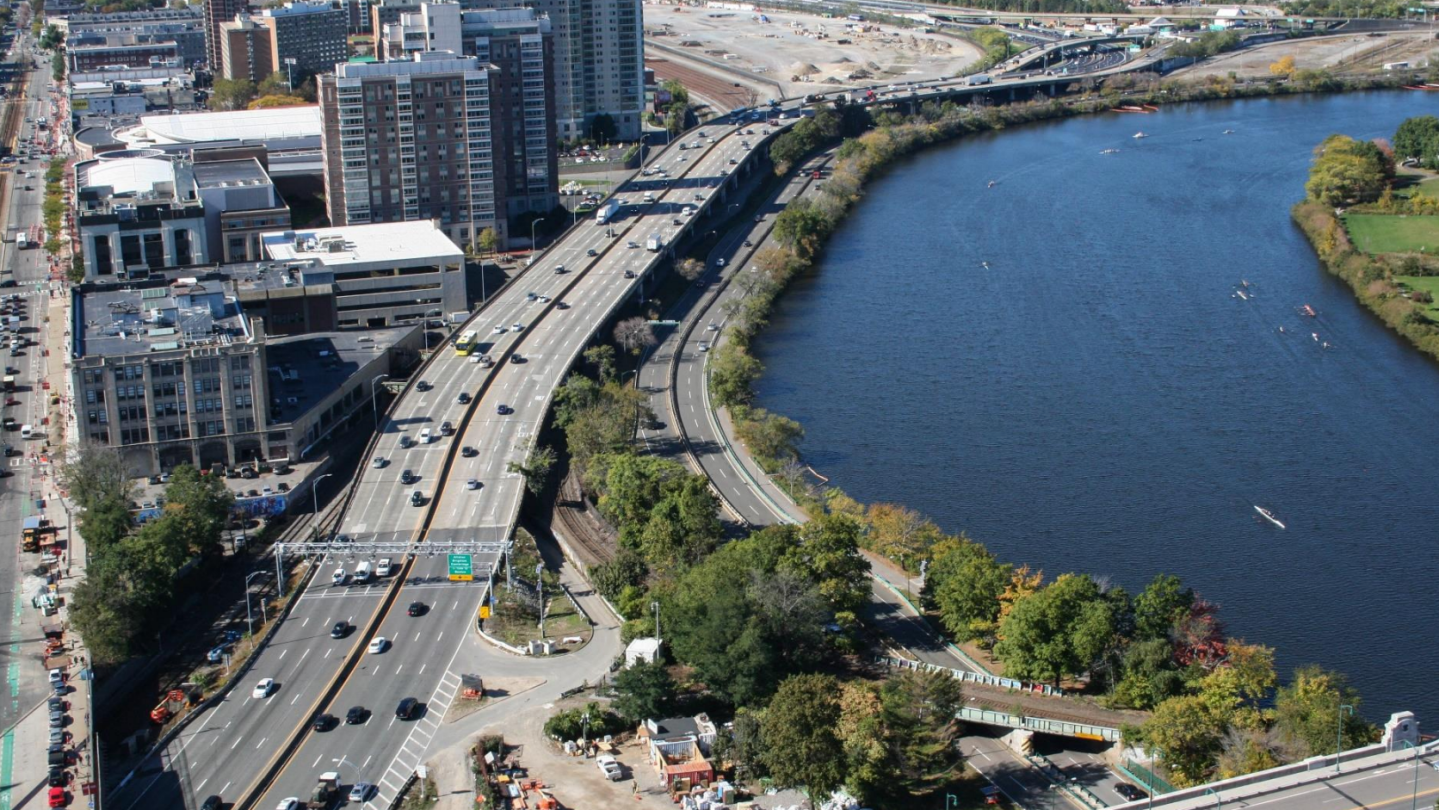
The most technically challenging part of the Allston Multimodal Project involves what planners are calling "the throat," the area of the Charles River waterfront where the Turnpike, Soldiers Field Road and two commuter rail tracks squeeze through a choke point that's just over 210 feet wide.
MassDOT has asserted that an eight-lane Turnpike is necessary to move the 147,000 vehicles that use the Turnpike on an average day (the four-lane Soldiers Field Road carries an additional 66,000 vehicles per day).
Bear in mind, though, that the City of Boston has set a goal of cutting car traffic in half within the next decade to meet its climate goals. MassDOT has not explained how present-day traffic volumes are relevant for a project that won't be finished until 2032, two years after the city aims to meet those targets and complete the transformative traffic-reducing agenda outlined in the GoBoston 2030 plan.
To fit in an eight-lane replacement Turnpike alignment, plus four lanes of the Soldiers Field Road, plus two new commuter rail tracks, and squeeze in a little more room for the Paul Dudley White Path, MassDOT had initially proposed an arrangement that would stack Soldiers Field Road on a viaduct over the Turnpike:

But when it came time to figure out how to build this, MassDOT suggested that a "temporary" highway would need to be built in the middle of the Charles River for several years while the new highways were built on the riverbank.
River advocates and the state's environmental permitting agency came out strongly against those plans, leading MassDOT to suggest simply rebuilding the existing Turnpike viaduct more or less in its current location.
For Allston neighbors who were hoping that the project would improve their access to the Charles River, rebuilding the 1960s-era viaduct was not a pleasant prospect.
“Putting the Turnpike up on an elevated viaduct just creates more noise and pollution for the surrounding neighborhood,” Allston resident and task force member Harry Mattison told Streetsblog in June 2020. “So many people have volunteered their time to creating better walking and biking connections to a greatly improved riverfront park. This is just an insult.”
In October, business organization A Better City presented a third option: one that puts the highway at the river's level. Boston University, whose campus is elevated above the project, expressed its support for this option in an October 2 letter the MassDOT, and even offered some of its own real estate to make it feasible:
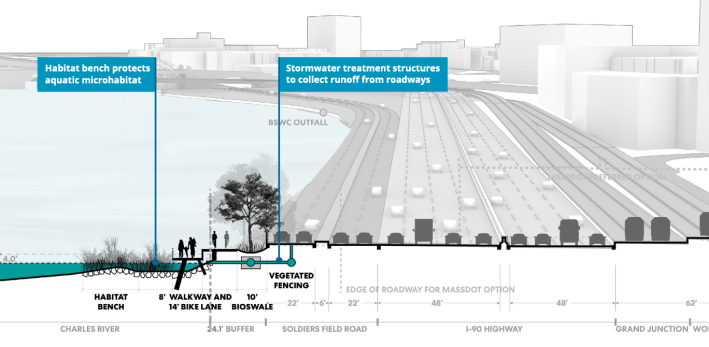
In September 2021, acknowledging strong public support for the "at grade" alternative, MassDOT announced that it would move forward with that option, settling one of the project's biggest unresolved design issues.
A 7-year construction project
According to its May 2022 federal grant funding application, MassDOT expects to take 7 full years to complete the entire Allston/I-90 project.
Builders will need to relocate the Turnpike, railroad lines and Soldiers Field Road to new alignments while the existing viaduct is demolished, then move them back again while the new roadways are built. All of this is going to be especially complicated and disruptive in the narrow "throat" section discussed above.
MassDOT is prepared to reduce the Turnpike to a 6-lane cross-section for much of the 2020s, and has said that the Framingham/Worcester line could also be reduced to a single track through the "throat" section for extended periods of time. Transit advocates worry that closing a track will constrain the MBTA's ability to add more train service when the need for better transit alternatives will be most acute.
The environmental review process

Now that consensus has emerged around the at-grade alternative for the "throat" section, the project will begin a detailed environmental review under the Massachusetts Environmental Policy Act and the National Environmental Policy Act, which requires MassDOT to analyze the project's impacts (including the construction impacts) with a detailed "environmental impact statement."
That two-year process is expected to kick off in late 2022, after MassDOT submits a "notice of project change" to reflect the updated conceptual design.
This will also be the time when MassDOT would be required to file for state and federal permits to build along the banks of the Charles River, which will be a probable point of contention from environmental groups.
Who's going to pay for it?
According to a May 2022 federal grant application, MassDOT expects to spend roughly $2 billion for all of the project's components. Only $754 million in funding has been committed to date from local and state sources, a significant amount of which has already been spent on conceptual project design and planning.
In a January 2019 memo that determined the project's current design, MassDOT Secretary Stephanie Pollack wrote that "the current MassDOT/MBTA capital plan does not provide funding to construct this critical project. A joint MassDOT staff/Board committee will work on developing a financing plan once a price tag for the selected Hybrid option is refined and finalized."
Harvard University, which, as noted earlier, is eager for the project to include multimodal connections to support its development ambitions for the site, has promised $50 million to fund the construction of West Station, plus an additional $8 million for an interim transit facility to serve the site (Harvard's commitments amount to about 3 percent of the project's total price tag).
It's worth noting that the Commonwealth's taxpayers have already been generous to Harvard where this property is concerned: the University bought this land from the state in 2003, when the board of the former Massachusetts Turnpike Authority voted to sell these 90 acres to Harvard for just $75 million, or about $105 million in 2019 dollars. For comparison's sake, a 1/3rd-acre parking lot on Newbury Street recently sold for $40 million.
What advocates are watching
Bike, pedestrian and transit advocates stress that there's a lot to like about the Allston Multimodal project. A public "task force" of several dozen stakeholders has been meeting regularly and has already managed to improve the state's proposal in significant ways.
But there are still some unresolved issues that advocates are watching as the project converges on a final design, including:
- When, exactly, will West Station be built?
- How will the state improve regional transit service to mitigate traffic hassles during the ten-year construction period?
- Will MassDOT be allowed to encroach on the present-day banks of the Charles River under state and federal environmental protection laws?
- How will bike and pedestrian access be maintained on Cambridge Street and the Paul Dudley White paths during each phase of construction?
- Why do project materials illustrate most of the new streets proposed north of West Station with 4- or 5-lane cross-sections, when such multi-lane streets have well-documented safety problems, especially for pedestrians?
Through the environmental review process, though, the agency will soon need to nail down these details and many others. We plan to cover this project closely, and will update this page as new information becomes available.

